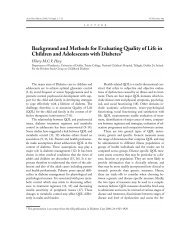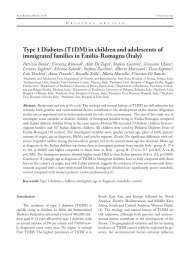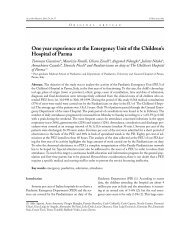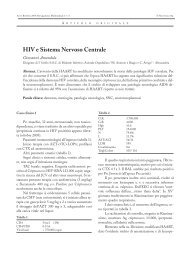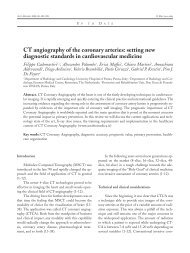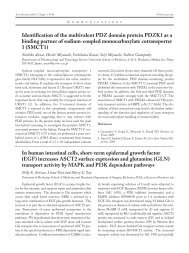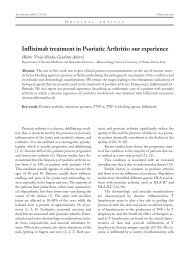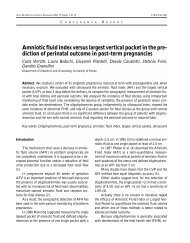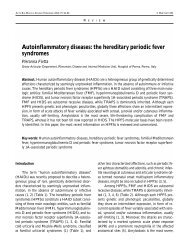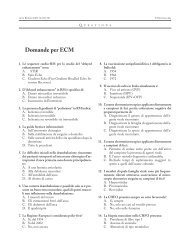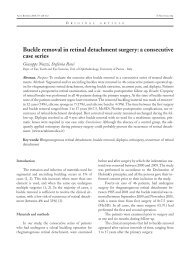Imaging for oncologic staging and follow-up: review ... - ResearchGate
Imaging for oncologic staging and follow-up: review ... - ResearchGate
Imaging for oncologic staging and follow-up: review ... - ResearchGate
You also want an ePaper? Increase the reach of your titles
YUMPU automatically turns print PDFs into web optimized ePapers that Google loves.
ACTA BIOMED 2008; 79: 85-91 © Mattioli 1885<br />
R E V I E W<br />
<strong>Imaging</strong> <strong>for</strong> <strong>oncologic</strong> <strong>staging</strong> <strong>and</strong> <strong>follow</strong>-<strong>up</strong>: <strong>review</strong> of<br />
current methods <strong>and</strong> novel approaches<br />
Filippo Cademartiri 1, 2 , Giacomo Luccichenti 3 , Erica Maffei 1 , Michele Fusaro 1 , Aless<strong>and</strong>ro<br />
Palumbo 1, 2 , Paolo Soliani 4 , Mario Sianesi 4 , Maurizio Zompatori 1 , Girolamo Crisi 1 , Gabriel P.<br />
Krestin 2<br />
Department of Radiology <strong>and</strong> Diagnostics 1 , University Hospital of Parma, Italy; Department of Radiology 2 , Erasmus Medical<br />
Center, Rotterdam, The Netherl<strong>and</strong>s; Department of Radiology 3 , IRCCS Santa Lucia, Roma, Italy; Department of Surgery 4 ,<br />
University Hospital of Parma, Italy<br />
Abstract. Purpose: To <strong>review</strong> the current radiological methodologies <strong>and</strong> guidelines <strong>for</strong> <strong>staging</strong> <strong>and</strong> <strong>follow</strong><strong>up</strong><br />
in oncology, <strong>and</strong> to give a perspective based on the available new technologies in <strong>oncologic</strong> radiology. Materials<br />
<strong>and</strong> Methods: The literature on cancer radiologic quantification in diagnostic phase <strong>and</strong> <strong>follow</strong>-<strong>up</strong> has<br />
been <strong>review</strong>ed. The main concepts <strong>and</strong> guidelines (official <strong>and</strong> non-official) have been extracted taking into<br />
account the period of publication <strong>and</strong> the available technology. The current World Health Organization<br />
(WHO) <strong>and</strong> Response Evaluation Criteria In Solid Tumors (RECIST) guidelines have been critically evaluated<br />
on the basis of technical literature on quantitative radiology applied to oncology. Pitfalls of previous<br />
<strong>and</strong> current guidelines have been exploited on the basis of currently available techniques <strong>for</strong> quantification.<br />
Results: Errors due to operator, scanner, software, <strong>and</strong> measurement technique inconsistency are all together<br />
far more relevant than the recognized thresholds applied <strong>for</strong> detecting therapeutic response. For this reason<br />
the volumetric assessment of cancer disease should be introduced. Conclusion: Even though the technical<br />
constraints are still prominent in the clinical practice, the design of clinical trials should be planned taking<br />
into account these new volumetric quantitative techniques. (www.actabiomedica.it)<br />
Key words: Tumor response, oncology, radiologic evaluation, criteria, guidelines, <strong>follow</strong>-<strong>up</strong>, <strong>staging</strong><br />
Introduction<br />
“All men naturally have an impulse to get knowledge…”<br />
– “Clearly, then, wisdom is rational knowledge<br />
concerning certain basic factors <strong>and</strong> principles.”<br />
(1). These assumptions, settled at the roots of western<br />
culture by Aristotle in his “Metafisica”, still guide the<br />
man in his search of knowledge <strong>and</strong> truth.<br />
Human cancer represents one of the main research<br />
topics of the last century. Recently it also became<br />
known as a dynamic living system rather than a<br />
circumscribed growing process. This multi-dimensional<br />
definition of cancer represents a new challenge<br />
in scientific methodology which can be summarized<br />
with the paradox of the hermeneutic circle (2): the<br />
theoretic prerequisite to know “the whole” to identify<br />
its constitutive parts <strong>and</strong> the necessity to proceed from<br />
the study of the parts to discern “the whole”. The<br />
paradox becomes evident since the study <strong>and</strong> <strong>follow</strong><strong>up</strong><br />
of cancer is currently per<strong>for</strong>med using a few parameters<br />
(i.e. a few parts).<br />
Theoretically, the biological <strong>follow</strong>-<strong>up</strong> in oncology<br />
is based on the assessment of the variation in the<br />
number of the neoplastic cells over time. However, no<br />
reliable estimation of the number of neoplastic cells<br />
can be per<strong>for</strong>med in vivo. In fact the cellularity of a tumor<br />
is estimated through morphological <strong>and</strong> functional<br />
indicators. This indirect approach severely af-
86 F. Cademartiri, G. Luccichenti, E. Maffei, et al.<br />
fects the accuracy of the estimation since these indicators<br />
are neither linearly correlated nor exclusively dependent<br />
on the cellularity of the neoplasm.<br />
The method <strong>for</strong> the selection, the sampling <strong>and</strong><br />
the analysis of these indirect indicators are there<strong>for</strong>e<br />
crucial in order to avoid the collection of several errors<br />
from multiple sources. A few criteria could be identified<br />
as <strong>follow</strong>s.<br />
It seems reasonable to select multiple indicators<br />
with a high <strong>and</strong> well known dependence on the intrinsic<br />
factors of the tumor. Conversely these indicators<br />
should be independent from the extrinsic factors<br />
of the tumor.<br />
The intra <strong>and</strong> inter-individual variability of the<br />
indicators should be well under the threshold above<br />
which the variation becomes clinically significant.<br />
This criterion is necessary in order to avoid intra <strong>and</strong><br />
inter-individual fluctuations to simulate a significant<br />
variation of the indicator. As a consequence the variation<br />
of the indicator above which the clinical outcome<br />
becomes significant should be known. The clinical<br />
significance of the variation should also be defined.<br />
A qualitative assessment through subjective judgments<br />
should be avoided. Theoretically, ordinal scales<br />
such as the TNM system should also be avoided. In<br />
fact in ordinal scales higher numbers represent higher<br />
stages. However, the intervals between stages are not<br />
necessarily equal or proportional. Moreover their correlation<br />
with the patient’s outcome has been subsequently<br />
established.<br />
Finally the intra <strong>and</strong> the inter-observer variability,<br />
the error of the measurement method should be<br />
under the threshold above which the variation becomes<br />
clinically significant <strong>for</strong> the same reasons already<br />
mentioned. Accuracy <strong>and</strong> reproducibility of the<br />
measurements are m<strong>and</strong>atory in order to overcome<br />
these drawbacks (3, 4).<br />
In radiological practice, as well as in scientific research<br />
studies, tumor volume is assumed to be representative<br />
of the number of neoplastic cells. This criterion<br />
may be argued since a neoplastic lesion may be a<br />
mixture of cells, vessels, interstitium, necrosis, <strong>and</strong> fluid<br />
collections. However, an estimation of the lesion<br />
volume rouses controversy regarding the most appropriate<br />
method.<br />
In this paper the current radiological methods<br />
<strong>and</strong> the guidelines <strong>for</strong> the assessment <strong>and</strong> <strong>follow</strong>-<strong>up</strong> of<br />
neoplastic diseases are <strong>review</strong>ed.<br />
Volume Estimation<br />
The proceeding of volume estimation can be described<br />
in two main phases. The first one is represented<br />
by data acquisition. It is interesting that, in the various<br />
guidelines <strong>for</strong> tumor assessment <strong>and</strong> <strong>follow</strong>-<strong>up</strong>,<br />
little attention is given to the acquisition technique. In<br />
fact, several factors can affect the perception of the<br />
measured object, namely: the tissue contrast between<br />
the object <strong>and</strong> surrounding structures (5-10); intravenous<br />
contrast material (11-13); volume averaging<br />
(6, 7, 14); <strong>and</strong> window settings (14). The second phase<br />
is represented by the measurement itself which is per<strong>for</strong>med<br />
with different methods.<br />
Linear measurements<br />
Linear measurements are the main method <strong>for</strong> the<br />
estimation of volume or the variation in size over time.<br />
The use of linear measurements <strong>for</strong> the <strong>follow</strong>-<strong>up</strong> of<br />
neoplastic lesions has been s<strong>up</strong>ported in the WHO<br />
guidelines by Miller et al. in 1981 (15), <strong>and</strong> in the RE-<br />
CIST guidelines by Therasse et al. in 2000 (16). These<br />
guidelines describe three aspects that should be considered<br />
in radiological <strong>follow</strong>-<strong>up</strong>, namely: the features required<br />
<strong>for</strong> a lesion to be measurable; how the measurements<br />
should be per<strong>for</strong>med (WHO requires two perpendicular<br />
linear measurements along the main axis of<br />
the lesion, while RECIST requires a single linear measurement);<br />
<strong>and</strong> criteria <strong>for</strong> assessing therapeutic response.<br />
Complete or partial response, stable or progressive<br />
disease, are defined in terms of variation in volume<br />
percentage. Although easy to <strong>follow</strong>, these guidelines<br />
raise several objections that are set out below.<br />
Defining the measurable lesion<br />
According to these guidelines there is no indication<br />
on how to proceed <strong>for</strong> infiltrative or bulky neoplasms<br />
involving structures with complex cross-sec-
<strong>Imaging</strong> <strong>for</strong> <strong>oncologic</strong> <strong>staging</strong> <strong>and</strong> <strong>follow</strong>-<strong>up</strong><br />
87<br />
tional anatomy or hollow viscera. This is the reason<br />
why the evaluation of volume variation in these lesions<br />
(i.e., assessment of tumor response) is often reached<br />
by subjective assessment. In a phantom study by Tiitola<br />
et al. the subjective estimation of the size of several<br />
irregular volumes was correct in 51% of cases (17).<br />
The same authors concluded that the radiologist’s volume<br />
estimation of irregular objects was suboptimal<br />
<strong>and</strong> should be replaced by computerized volume estimation.<br />
The radiologist’s subjective estimation of regular<br />
structures also provides poor results (18).<br />
Mathematical factors<br />
From a strictly mathematical st<strong>and</strong>point it is not<br />
correct to assess the variation in lesion volume using<br />
two-dimensional or one-dimensional criteria. If these<br />
techniques are adopted, the correlations are not linear,<br />
<strong>and</strong> consequently the response criteria will not be linear.<br />
James et al. stated that one linear measurement<br />
shows a higher correlation with the cells killed by a<br />
st<strong>and</strong>ard dose of chemo-radiotherapy (19). On the<br />
contrary, Hilsenbeck <strong>and</strong> Von Hoff demonstrated that<br />
the correlation between tumor diameter <strong>and</strong> cell number<br />
is not linear (20): it is the logarithm of the diameter,<br />
<strong>and</strong> not the raw values, which is linearly related<br />
to the logarithm of the cell number.<br />
Hilsenbeck <strong>and</strong> Von Hoff also noted that in studies<br />
s<strong>up</strong>porting the use of linear measurements, these<br />
measurements were in some cases expressed as natural<br />
logarithms prior to analysis with high correlation<br />
values between the linear measurement <strong>and</strong> the volume<br />
(19, 21). As a result, the linear relationship between<br />
linear measurements <strong>and</strong> volume is derived<br />
from the difference in scale (20). In clinical practice,<br />
however, the use of logarithmic scales does not appear<br />
to be feasible.<br />
Geometric factors<br />
Without any scientific discussion it is clear that the<br />
assumption that it is possible to reliably assess a volume<br />
from linear measurements is not acceptable in biology.<br />
There<strong>for</strong>e linear measurements can hardly be applied to<br />
estimate the volume of irregular solids (22). The assumption<br />
that focal lesions are spherical is methodologically<br />
erroneous since the spherical shape should be<br />
demonstrated (20). Linear measurements could be used<br />
<strong>for</strong> spherical <strong>and</strong> small lesions, but may there<strong>for</strong>e introduce<br />
an additional source of error. Although methodologically<br />
incorrect, it can be argued that such an error<br />
could be tolerated if it is well below the threshold above<br />
which the variation in volume is clinically significant.<br />
The problem is then defining what is clinically relevant.<br />
In many cases the variability of tumor shapes <strong>and</strong> volumes<br />
does not allow such calculations (23). Moreover,<br />
linear measurements critically depend on the level <strong>and</strong><br />
orientation of the plane where they are per<strong>for</strong>med. This<br />
determines poor reproducibility (23, 24). Finally, the<br />
longitudinal axis is not considered while lesion growth<br />
is not necessarily uni<strong>for</strong>m (4).<br />
Structural factors<br />
As previously stated, a lesion is a mixture of cells,<br />
vessels, interstitium, necrosis <strong>and</strong> fluid collections. An<br />
increase in the volume of one of the non-cellular components<br />
(i.e., necrosis) may mask a decrease in cell<br />
numbers. As a result the tumor volume partially correlates<br />
with the cell number. This task could be better<br />
challenged <strong>for</strong> instance, with software tools that are<br />
able to quantify the amount of tumor with contrast<br />
enhancement. In our opinion, the response criteria<br />
should be adapted to the histology <strong>and</strong> natural history<br />
of the tumor. A 30% volume reduction may be a<br />
poor result in fast-growing tumors but it may also be<br />
considered a good outcome in slow-growing neoplasms.<br />
Summing the areas<br />
A method <strong>for</strong> estimating the volume from crosssectional<br />
images which has been widely used prior to<br />
the development of more advanced technologies is the<br />
multiplication of the reconstruction interval with the<br />
result of the sum of the area of the lesion in each contiguous<br />
cross-sectional image (5, 9, 14, 17, 18, 25-30).<br />
Theoretically this method does not differ from more<br />
recent three-dimensional techniques. The latter
88 F. Cademartiri, G. Luccichenti, E. Maffei, et al.<br />
should be preferred because they are less time consuming<br />
<strong>and</strong> more accurate.<br />
Three-dimensional techniques<br />
Three-dimensional techniques achieved higher<br />
reproducibility when compared to conventional methods<br />
(12). The intrinsic error of these techniques have<br />
been assessed mostly in phantom studies. The error<br />
can be hardly validated in-vivo by measuring the true<br />
lesion volume of the pathological specimen. In fact in<br />
this instance, the spatial relationships between the lesion<br />
<strong>and</strong> its surrounding are lost, the intra- <strong>and</strong> extracellular<br />
fluids <strong>and</strong> the blood content are altered, <strong>and</strong><br />
the true volume of the neoplasm cannot be evaluated<br />
(3, 11, 13).<br />
Three-dimensional volume estimation techniques<br />
prevent several problems encountered with the<br />
methods previously described , since the volume is obtained<br />
directly by counting the number of voxels composing<br />
the lesion. Tumor <strong>follow</strong>-<strong>up</strong> using this method<br />
takes the three dimensions into account, <strong>and</strong> the technique<br />
is unaffected by the geometrical factors. No<br />
studies nor clinical literature have been per<strong>for</strong>med yet<br />
applying these techniques. There<strong>for</strong>e new criteria<br />
should be identified. Other parameters should be<br />
probably considered in the identification of those criteria,<br />
such as the histological type, tumor location, <strong>and</strong><br />
inner tumoral structure.<br />
Lesion margins <strong>and</strong> tumor structure may be identified<br />
through the use of advanced segmentation <strong>and</strong><br />
texture analysis techniques. The lesion can be defined<br />
either manually or using semi-automated or automated<br />
techniques (3, 11, 31, 32). While the <strong>for</strong>mer<br />
method still relies on the operator’s subjective perception,<br />
the latter may be based on analytic, morphological<br />
<strong>and</strong> knowledge-based operations (33, 34). Both<br />
methods can allow, through thresholding <strong>for</strong> instance,<br />
a more precise analysis of the lesion components.<br />
Tumor Structure<br />
Some authors evidenced the usefulness of the assessment<br />
of structural changes in <strong>oncologic</strong> <strong>follow</strong>-<strong>up</strong><br />
(35-37). These changes can be gro<strong>up</strong>ed in three categories<br />
according to their underlying etio-pathogenetic<br />
mechanisms: acute <strong>and</strong> chronic inflammation, reparative<br />
or amorphous structures, <strong>and</strong> tumor genesis.<br />
Although these criteria can provide useful keys in<br />
directing the evaluation, they are often not adequate in<br />
establishing <strong>and</strong> particularly in quantifying tumor response.<br />
No quantitative studies have been per<strong>for</strong>med<br />
to assess their reliability. Finally the differential diagnosis<br />
between tumor, inflammatory, reparative or degenerative<br />
changes is often challenging.<br />
Discussion<br />
This <strong>review</strong> of the methods that have been tested<br />
<strong>for</strong> volume estimation <strong>and</strong> <strong>for</strong> <strong>oncologic</strong> <strong>follow</strong>-<strong>up</strong><br />
suggests the rejection of linear measurements since<br />
they are unreliable if not misleading. Accuracy <strong>and</strong> reproducibility<br />
are particularly important if the consistency<br />
of a clinical trial or a scientific study depends<br />
partly or completely on measurements. The measurement<br />
of lung nodule diameters by means of chest X-<br />
rays (CXR) demonstrated an inter-observer variability<br />
of 25% (38). In studies based on cross-sectional<br />
imaging with segmentation techniques, intra- <strong>and</strong> inter-observer<br />
variability was respectively assessed at 3%<br />
<strong>and</strong> 3.76% (24). Despite these apparently encouraging<br />
results, several patients (ranging from 17.7% to 26%)<br />
can be reclassified in a different category of <strong>oncologic</strong><br />
response depending on the measurement method (i.e.<br />
linear measurement vs. three-dimensional segmentation<br />
technique) (23, 39). The impact of this observation<br />
on lower stages of disease is evident.<br />
Three-dimensional techniques are still time consuming<br />
<strong>and</strong> not widely available (3, 4, 40). These facts<br />
lead radiologists <strong>and</strong> oncologists not to use them <strong>and</strong><br />
on the contrary to prefer linear measurements. Although<br />
this can be understood in the clinical practice<br />
(quick <strong>and</strong> easy approach), it should not be tolerated<br />
in clinical trials. In other words, while the assessment<br />
of therapeutic response may be sub-optimal in the<br />
clinical practice due to the limitation of the resources,<br />
the efficacy of a therapy must be assessed with accurate<br />
<strong>and</strong> repeatable techniques (41, 42).
<strong>Imaging</strong> <strong>for</strong> <strong>oncologic</strong> <strong>staging</strong> <strong>and</strong> <strong>follow</strong>-<strong>up</strong><br />
89<br />
The point can be resumed in two questions: 1) Is<br />
the volume adequate as a radiological parameter <strong>for</strong><br />
tumor assessment <strong>and</strong> <strong>follow</strong>-<strong>up</strong>? If the appropriate<br />
method to obtain the volume is used the answer may<br />
be “yes”. 2) Is volumetric assessment the only current<br />
available radiologic parameter <strong>for</strong> <strong>oncologic</strong> <strong>follow</strong><strong>up</strong>?<br />
The development of new technologies such as<br />
functional <strong>and</strong> molecular imaging with MRI <strong>and</strong> PET<br />
will soon introduce new parameters that should be<br />
considered in oncology.<br />
Some of these techniques are based on the volumetric<br />
approach which in fact means to overcome the<br />
discretization of the analysis that occurs with linear<br />
measurements. The mentioned guidelines gave little<br />
attention on the acquisition technique. This is underst<strong>and</strong>able<br />
since the voxel size does not significantly influence<br />
linear measurements. Yet the acquisition technique<br />
is rather a critical aspect <strong>for</strong> three-dimensional<br />
3D imaging <strong>and</strong> more advanced techniques.<br />
These technologies will be of inestimable value<br />
<strong>for</strong> the assessment of the efficacy of anti-tumoral therapy,<br />
even though not <strong>for</strong> wide-spread clinical use. An<br />
additional aspect of these new techniques is that they<br />
facilitate to consider the cancer as a systemic disease<br />
due to their increased sensitivity <strong>and</strong> accurate quantification.<br />
The impelling results achieved with these experimental<br />
technologies emphasize the requirement to<br />
build a common language which could be defined as<br />
the concept of “mathesis universalis” from the great<br />
mathematician <strong>and</strong> philosopher Leibniz (43).<br />
Such a common language should include not only<br />
the methodological aspect, but also the conception<br />
itself of the neoplastic disease.<br />
The methodological aspect should enclose the<br />
st<strong>and</strong>ardization of measurement units <strong>for</strong> some elementary<br />
characteristics.<br />
With reference to the conception of neoplastic<br />
disease, the theoretical requirement to isolate<br />
the problem (the tumor) entails the loss of its multidimensionality<br />
<strong>and</strong> its definition as distinct entity<br />
from the organism. From a thermodynamic st<strong>and</strong>point,<br />
there is the tendency to consider as “closed” a<br />
living <strong>and</strong> “open” system, which is part of a living system.<br />
The methodological option is then to obtain few<br />
results of a limited entity or to collect more “points of<br />
view” on the complete “man-system”. In this last case<br />
the validation of a system of measurement, <strong>for</strong> instance,<br />
should be per<strong>for</strong>med through its correlation<br />
with the prognosis of the patient. This represents the<br />
only practicable way if a comparison with other systems<br />
of measurement is not possible or if the entity is<br />
of multi-factorial nature.<br />
In conclusion a closer collaboration between radiologists<br />
<strong>and</strong> oncologists is recommended. New<br />
methods <strong>and</strong> new criteria should be established <strong>for</strong> radiological<br />
assessment of tumor response considering<br />
the new incoming technologies <strong>and</strong>, above all a common<br />
language is needed.<br />
References<br />
1. Aristotle. Methaphysics. New York: University of Michigan<br />
Press; 1952.<br />
2. Gadamer HG. Truth <strong>and</strong> Method. 2nd ed. London: Crossroad;<br />
1989.<br />
3. Mahr A, Levegrun S, Bahner ML, Kress J, Zuna I, Schlegel<br />
W. Usability of semiautomatic segmentation algorithms <strong>for</strong><br />
tumor volume determination. Invest Radiol 1999; 34: 143-<br />
50.<br />
4. Van Hoe L, Van Cutsem E, Vergote I, Baert AL, Bellon E,<br />
D<strong>up</strong>ont P, et al. Size quantification of liver metastases in patients<br />
undergoing cancer treatment: reproducibility of one-,<br />
two-, <strong>and</strong> three-dimensional measurements determined with<br />
spiral CT. Radiology 1997; 202: 671-5.<br />
5. Brenner DE, Whitley NO, Houk TL, Aisner J, Wiernik P,<br />
Whitley J. Volume determinations in computed tomography.<br />
Jama 1982; 247: 1299-302.<br />
6. Filippi M, Horsfield MA, Campi A, Mammi S, Pereira C,<br />
Comi G. Resolution-dependent estimates of lesion volumes<br />
in magnetic resonance imaging studies of the brain in multiple<br />
sclerosis. Ann Neurol 1995; 38: 749-54.<br />
7. Bartzokis G, Altshuler LL, Greider T, Curran J, Keen B,<br />
Dixon WJ. Reliability of medial temporal lobe volume measurements<br />
using re<strong>for</strong>matted 3D images. Psychiatry Res 1998;<br />
82: 11-24.<br />
8. Disler DG, Marr DS, Rosenthal DI. Accuracy of volume<br />
measurements of computed tomography <strong>and</strong> magnetic resonance<br />
imaging phantoms by three-dimensional reconstruction<br />
<strong>and</strong> preliminary clinical application. Invest Radiol 1994;<br />
29: 739-45.<br />
9. Nawaratne S, Fabiny R, Brien JE, Zalcberg J, Cosolo W,<br />
Whan A, et al. Accuracy of volume measurement using helical<br />
CT. J Comput Assist Tomogr 1997; 21: 481-6.
90 F. Cademartiri, G. Luccichenti, E. Maffei, et al.<br />
10. Nazarian LN, Park JH, Halpern EJ, Parker L, Johnson PT,<br />
Lev-Toaff AS, et al. Size of colorectal liver metastases at abdominal<br />
CT: comparison of precontrast <strong>and</strong> postcontrast<br />
studies. Radiology 1999; 213: 825-30.<br />
11. Schwartz LH, Ginsberg MS, DeCorato D, Rothenberg<br />
LN, Einstein S, Kijewski P, et al. Evaluation of tumor measurements<br />
in oncology: use of film-based <strong>and</strong> electronic<br />
techniques. J Clin Oncol 2000; 18: 2179-84.<br />
12. Quivey JM, Castro JR, Chen GT, Moss A, Marks WM.<br />
Computerized tomography in the quantitative assessment<br />
of tumour response. Br J Cancer S<strong>up</strong>pl 1980; 41: 30-4.<br />
13. Vaidyanathan M, Clarke LP, Velthuizen RP, Ph<strong>up</strong>hanich S,<br />
Bensaid AM, Hall LO, et al. Comparison of s<strong>up</strong>ervised<br />
MRI segmentation methods <strong>for</strong> tumor volume determination<br />
during therapy. Magn Reson <strong>Imaging</strong> 1995; 13:719-<br />
728.<br />
14. Van Hoe L, Haven F, Bellon E, Baert AL, Bosmans H,<br />
Feron M, et al. Factors influencing the accuracy of volume<br />
measurements in spiral CT: a phantom study. J Comput Assist<br />
Tomogr 1997; 21: 332-8.<br />
15. Miller AB, Hoogstraten B, Staquet M, Winkler A. Reporting<br />
results of cancer treatment. Cancer 1981; 47: 207-<br />
14.<br />
16. Therasse P, Arbuck SG, Eisenhauer EA, W<strong>and</strong>ers J, Kaplan<br />
RS, Rubinstein L, et al. New guidelines to evaluate the response<br />
to treatment in solid tumors. European Organization<br />
<strong>for</strong> Research <strong>and</strong> Treatment of Cancer, National Cancer<br />
Institute of the United States, National Cancer Institute<br />
of Canada. J Natl Cancer Inst 2000; 92: 205-16.<br />
17. Tiitola M, Kivisaari L, Tervahartiala P, Palomaki M,<br />
Kivisaari RP, Mankinen P, et al. Estimation or quantification<br />
of tumour volume? CT study on irregular phantoms.<br />
Acta Radiol 2001; 42: 101-5.<br />
18. Friedman MA, Resser KJ, Marcus FS, Moss AA, Cann<br />
CE. How accurate are computed tomographic scans in assessment<br />
of changes in tumor size? Am J Med 1983; 75:<br />
193-8.<br />
19. James K, Eisenhauer E, Christian M, Terenziani M, Vena<br />
D, Muldal A, et al. Measuring response in solid tumors:<br />
unidimensional versus bidimensional measurement. J Natl<br />
Cancer Inst 1999; 91: 523-8.<br />
20. Hilsenbeck SG, Von Hoff DD. Measure once or twice -<br />
does it really matter? J Natl Cancer Inst 1999; 91: 494-5.<br />
21. Dachman AH, MacEneaney PM, Adedipe A, Carlin M,<br />
Schumm LP. Tumor size on computed tomography scans:<br />
is one measurement enough? Cancer 2001; 91: 555-60.<br />
22. Euhus DM, Hudd C, LaRegina MC, Johnson FE. Tumor<br />
measurement in the nude mouse. J Surg Oncol 1986; 31:<br />
229-34.<br />
23. Sorensen AG, Patel S, Harmath C, Bridges S, Synnott J,<br />
Sievers A, et al. Comparison of diameter <strong>and</strong> perimeter<br />
methods <strong>for</strong> tumor volume calculation. J Clin Oncol 2001;<br />
19: 551-7.<br />
24. Hopper KD, Kasales CJ, Van Slyke MA, Schwartz TA,<br />
TenHave TR, Jozefiak JA. Analysis of interobserver <strong>and</strong> intraobserver<br />
variability in CT tumor measurements. AJR Am<br />
J Roentgenol 1996; 167: 851-4.<br />
25. Breiman RS, Beck JW, Korobkin M, Glenny R, Akwari<br />
OE, Heaston DK, et al. Volume determinations using computed<br />
tomography. AJR Am J Roentgenol 1982; 138: 329-33.<br />
26. Heffron TG, Anderson JC, Matamoros A, Jr., Pillen TJ,<br />
Antonson DL, Mack DR, et al. Preoperative evaluation of<br />
donor liver volume in pediatric living related liver transplantation:<br />
how accurate is it? Transplant Proc 1994; 26:<br />
135.<br />
27. Yokoyama M, Watanabe K, Inatsuki S, Ochi K, Takeuchi<br />
M. Measurement of renal parenchymal volume using computed<br />
tomography. J Comput Assist Tomogr 1982; 6: 975-7.<br />
28. Tarhan NC, Uslu Tutar N, Yologlu Z, Coskun M, Karakayali<br />
H, Bilgin N. Volume measurement by computed tomography<br />
in auxiliary heterotopic partial liver transplant recipients:<br />
<strong>follow</strong>-<strong>up</strong> results. Transplant Proc 2000; 32: 601-3.<br />
29. Heymsfield SB, Fulenwider T, Nordlinger B, Barlow R,<br />
Sones P, Kutner M. Accurate measurement of liver, kidney,<br />
<strong>and</strong> spleen volume <strong>and</strong> mass by computerized axial tomography.<br />
Ann Intern Med 1979; 90: 185-7.<br />
30. Gong QY, Tan LT, Romaniuk CS, Jones B, Brunt JN,<br />
Roberts N. Determination of tumour regression rates during<br />
radiotherapy <strong>for</strong> cervical carcinoma by serial MRI:<br />
comparison of two measurement techniques <strong>and</strong> examination<br />
of intraobserver <strong>and</strong> interobserver variability. Br J Radiol<br />
1999; 72: 62-72.<br />
31. Sohaib SA, Turner B, Hanson JA, Farquharson M, Oliver<br />
RT, Reznek RH. CT assessment of tumour response to<br />
treatment: comparison of linear, cross-sectional <strong>and</strong> volumetric<br />
measures of tumour size. Br J Radiol 2000; 73:1178-<br />
84.<br />
32. Farjo LA, Williams DM, Bl<strong>and</strong> PH, Francis IR, Meyer<br />
CR. Determination of liver volume from CT scans using<br />
histogram cluster analysis. J Comput Assist Tomogr 1992; 16:<br />
674-83.<br />
33. Bellon E, Feron M, Maes F, Hoe LV, Delaere D, Haven F,<br />
et al. Evaluation of manual vs semi-automated delineation<br />
of liver lesions on CT images. Eur Radiol 1997; 7: 432-8.<br />
34. Bae KT, Giger ML, Chen CT, Kahn CE, Jr. Automatic<br />
segmentation of liver structure in CT images. Med Phys<br />
1993; 20: 71-8.<br />
35. Ferrozzi F, Tognini G, Pavone P. Structural changes induced<br />
by antineoplastic therapies: keys to evaluate tumor<br />
response to treatment. Eur Radiol 2002; 12: 928-37.<br />
36. Husb<strong>and</strong> JE. Monitoring tumour response. Eur Radiol<br />
1996; 6: 775-85.<br />
37. MacVicar D, Husb<strong>and</strong> JE. Assessment of response <strong>follow</strong>ing<br />
treatment <strong>for</strong> malignant disease. Br J Radiol 1997; 70<br />
Spec No: S41-49.<br />
38. Gurl<strong>and</strong> J, Johnson RO. How reliable are tumor measurements?<br />
Jama 1965; 194: 973-8.<br />
39. Hopper KD, Kasales CJ, Eggli KD, TenHave TR, Belman<br />
NM, Potok PS, et al. The impact of 2D versus 3D quantitation<br />
of tumor bulk determination on current methods of<br />
assessing response to treatment. J Comput Assist Tomogr<br />
1996; 20: 930-7.<br />
40. Hopper KD, Singapuri K, Finkel A. Body CT <strong>and</strong> <strong>oncologic</strong><br />
imaging. Radiology 2000; 215: 27-40.
<strong>Imaging</strong> <strong>for</strong> <strong>oncologic</strong> <strong>staging</strong> <strong>and</strong> <strong>follow</strong>-<strong>up</strong><br />
91<br />
41. Moertel CG, Hanley JA. The effect of measuring error on<br />
the results of therapeutic trials in advanced cancer. Cancer<br />
1976; 38: 388-94.<br />
42. Lavin PT, Flowerdew G. Studies in variation associated<br />
with the measurement of solid tumors. Cancer 1980; 46:<br />
1286-90.<br />
43. Leibniz GW. Nouveaux essais sur l’entendement. In: Gerhardt<br />
CI, editor. Die philosophischen Schriften von Gottfried<br />
Wilhelm Leibniz. Berlin: Hildesheim Olms; 1882:<br />
469.<br />
Accepted: 26th May 2008<br />
Correspondence: Filippo Cademartiri, MD, PhD<br />
Department of Radiology <strong>and</strong> Diagnostics<br />
University Hospital of Parma<br />
Viale A. Gramsci, 14<br />
43100 Parma, Italy<br />
Tel. +39 0521 961833<br />
E-mail: filippocademartiri@hotmail.com; www.actabiomedica.it



